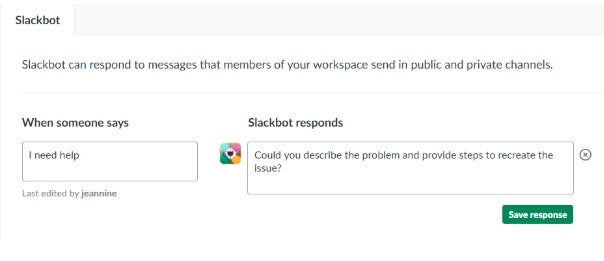Posted on 5/30/2018 in Business and Strategy
Whether or not you realize it, you are probably interacting with chatbots on an almost daily basis. A chatbot is a computer program that is designed to simulate human conversation. It may appear in the form of a text message, a pop-up on a website, an instant-message style chat window or a smart speaker (think “Alexa”).
Computer programs are becoming more advanced all the time and this is just another example of how humans can use computers to help automate repetitive, time consuming tasks. Chatbots can be broken up into two types:
- Simple: These are pre-programmed bots that can be configured to send canned responses when a certain keyword or action triggers them. Rules are established and the chatbot responds when they recognize a keyword that matches one of these rules. An example of this can be found on the popular chat program, Slack. They have the concept of “Slackbot responses” where you can set key words or phrases that slack will look for in various chat channels and if there is a match, it will automatically respond with whatever pre-programmed reply you have specified.

- Smart: This type of bot relies on artificial intelligence when communicating with users. It uses machine learning to try to understand requests and questions and reply with a logical response. It uses probability to run through possible outcomes and replies with the one it deems most likely to be what the user is looking for. It understands language and gets continuously smarter from its interactions with humans. A cool example of a smart chatbot that I came across is MedWhat. It’s an intelligent virtual assistant that can answer health questions instantly. According to their site, It’s powered by “an intelligent super-computer that learns about medicine everyday and over time about your health record and medical questions history.”
Using Chatbots for Marketing and Sales
Chatbots are really helpful in my daily life. They let me take care of simple tasks quickly and easily. Time to reorder cat food from Amazon? I just stand in my kitchen and say: “Alexa, reorder cat food.” She confirms it and seconds later, I’m done. My pharmacy even sends me texts messages when I have a prescription up for refill. All I need to do is text back “YES” and that alerts them to refill it for me. I get another message when it’s ready - all through an automated bot.
They can also be a great tool for sales and marketing. Below are just a few of the ways that you can use them to benefit your business:
- Communicate with visitors on your website: You can use chatbots to trigger conversations on your website, help users find the information they are looking for, and help with basic customer service requests.
- Qualify leads: Bots like like Drift’s LeadBot can ask qualifying questions, book meetings and create leads in your CRM so your salespeople can focus their time working deals for qualified leads and not wasting time trying to sift through the noise.
- Integrate with messaging platforms: Slack and Facebook Messenger have lots of different types of bots. The Slack bots can be useful for internal business operations: to-do lists, scheduling, etc. Facebook Messenger is great for lead generation - by putting the right products in front of customers while they are using chat.
- Sell your product: You can create bots that sell products by interacting with a customer to determine their needs and then make recommendations - all without needing to pull in an actual salesperson.
- Provide a personalized experience: Even though bots aren’t human, there are things they can do to make the experience feel personal. It could include asking questions to get to know you better and then providing you with information that it thinks you will find useful. It may also use your behavior on a website to get a sense of what you are looking for and then pop-up a message tailored just for you based on your specific activities and interactions.
- Send relevant notifications: Chatbots can be used to send relevant product updates, reminders or promotional messages based on information the bot has already learned about you from past behavior or because you matched a set of pre-programmed criteria.
- Gather customer feedback: A lot of people don’t like to spend time taking surveys, which can make it hard for a company to measure success and satisfaction. A chatbot can accomplish this task more subtly by introducing questions organically throughout the course of a conversation and then analyze the data that has been gathered.
Overall, chatbots can be very useful and save you time and resources, while also enhancing your user’s overall experience with your business. People are less likely to pick up the phone so these bots provide them additional options to reach you on the channels where they are already active. It’s really a win-win for everyone.
Thinking about setting up a chatbot on your site?
Reach out to us today to find out how we can help!
Related Articles

Outdated or Outstanding? How to Tell If Your Website Needs a Refresh
Your website is the digital face of your business. It serves as a first impression, a marketing tool, and a resource for potential customers. [...]

Preparing a Website Redesign Budget for 2025: A Step-by-Step Guide
As we approach 2025, businesses are recognizing the necessity of a fresh, user-friendly website to stay competitive in a rapidly evolving digital [...]

Demystifying SPF, DKIM and DMARC: Strengthening Email Security
With Slack and other instant messaging services handling more and more of our online communication, email can sometimes feel like a newspaper being [...]
